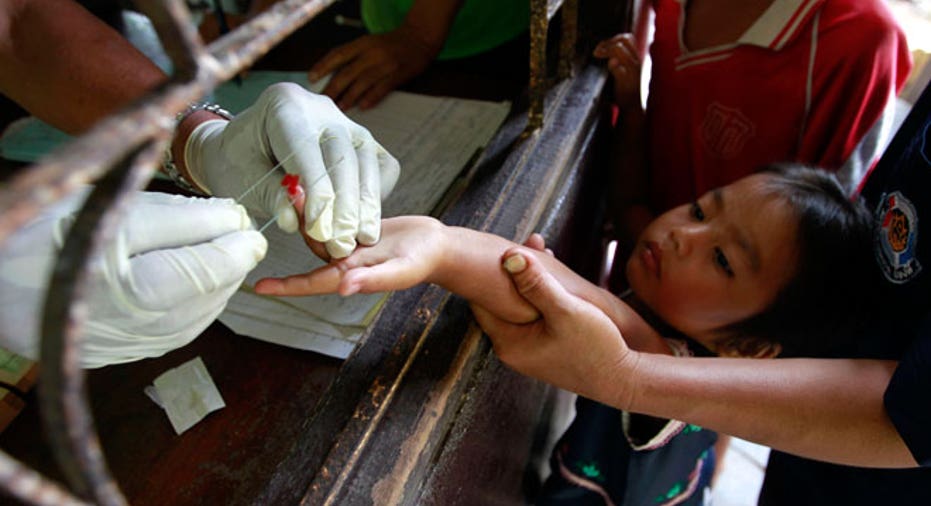Detecting Malaria Using a Cell's Electric Vibe

Hundreds of thousands of children die from malaria each year with about half of the world’s population at risk of the disease at any given time, but new research has the potential to catch this and other deadly diseases before they reach maturity.
Traditionally, malaria, the mosquito-borne disease caused by a parasite and delivering flu-like symptoms, can be detected by examining a drop of blood under a microscope.
If the disease is advanced enough, and if the patient is experiencing symptoms and living in a place such as Africa where the disease is easily transmittable through mosquitoes, a doctor can detect compromised cells and give a diagnosis without delay.
However, late-stage detection isn't foolproof and sometimes the diagnosis comes too late. In 2010, the latest data available from the World Health Organization, there were an estimated 660,000 malaria deaths due to the 219 million cases recorded.
But what if there were a way to detect the disease before it got to that point, as easily as, say, a woman a day late on her menstrual cycle can test for pregnancy?
New technologies being studied by scientists affiliated with the Massachusetts Institute of Technology may be able to help doctors detect disease at the point of impact using the electrical makeup of infected cells.
“There’s no question they’ve opened a new area of thinking here,” said Dr. Jeffrey Gelfand, an attending physician at Massachusetts General Hospital who was not involved in the project.
This could offer a “very significant advancement in point of care diagnosis,” he notes, another innovative brick to add to the growing edifice of point-of-care diagnosis that has already enabled patients to quickly test for pregnancy, strep throat and high glucose levels.
How it Works
The MIT researchers say they’ve found a way to detect malarial infection using an experimental microfluidic device that measures the changes in a cell’s electrical properties. It can differentiate between early-stage infected cells and healthy ones by the specific electrical signal they give off.
Once a red blood cell is invaded by the malaria parasite plasmodium falciparum, the host cell starts to undergo a specific physical and biochemical shift, becoming more rigid and clogging blood vessel walls, which is easy to detect under a microscope.
However, before the cell's transformation moves beyond the ring stage, or the earliest stage of infection, the disease is difficult to detect. Prior to this study, it was unclear whether cells even gave off different electrical signals that early in the process.
With that fact now known, researchers say the technology would enable doctors to read cell changes, even prescribe medicine, within those first crucial hours.
The work, published in an Aug. 8, journal, would help lower the cost of detecting malaria, especially if it can be miniaturized so it can be easily disseminated to clinics across the world.
“Ultimately the goal would be to create a postage stamp-sized device with integrated electronics that can detect if a person has malaria and at what stage,” Anantha Chandrakasan, an MIT professor of Electrical Engineering who specializes in developing low-power electronic devices, told the university’s newspaper MIT News.
Global Dissemination
It’s unclear how long it would take to get something like this to the market.
But once the research is topped off and the device begins the process toward approval, Gelfand says it could take a few years and cost somewhere in the millions of dollars to get to the point where it can be affordably manufactured and eventually distributed.
Non-invasive, point-of-care diagnostic instruments made by the likes of Abbott Labs (NYSE:ABT), Johnson & Johnson (NYSE:JNJ) and Siemens (NYSE:SI) typically go through a less rigorous approval process, which means fewer clinical trials, costs and a faster timeline compared with pharmaceutical and more invasive drugs and devices.
“Point of care diagnosis for infectious diseases has enormous potential,” says Gelfand, who is the program leader of biodetection and sepsis control at the Center for Integration of Medicine & Innovative Technology. “This could have a positive impact on how we take care of patients in both bringing down costs and improving results -- enormously faster and more helpful."
MIT researchers believe this rapid-fire detection method could also be used to find other infectious diseases that transform the nature of cells, eventually being used as ubiquitously as other portable point of care devices. (Similar ones are also being developed to detect HIV.)
“This is absolutely applicable to diagnosis of other kinds of diseases,” Gelfand said.
The MIT device would join the slew of already effective malaria test kits. But with its ability to offer a glimpse at the earliest stages of disease, closest to the point of infection, it could potentially help save millions of lives down the road, many of them children.